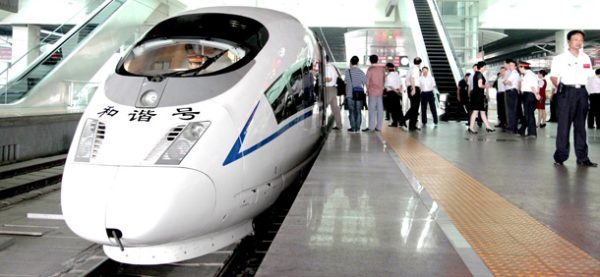The Future Isn’t Free

Charlotte is once more at a crossroads: future challenges abound—in education, environmental sustainability, and social equity to name only three. Even more important is the question of transportation infrastructure, and I make no apologies for returning to one of my favorite topics because of its primary importance to the economic growth and prosperity for our city.
This issue is particularly relevant in Charlotte today, with plans for high-speed rail connections to other major east coast cities intersecting with difficult local conversations about public transit within the city and county. The key issues in both contexts are:
• public and political commitment to rail transit as a basic component of a more sustainable future; and
• the recognition that future progress isn’t free; we need to pay for what we need.
But now, investment in rail travel has become a favorite target of conservative commentators and legislators, with several planned projects under attack or likely to be scrapped. Fox News has ridiculed high-speed rail as a “boondoggle,” an attitude amplified by conservative pundits and many Tea Party members.
It’s a measure of how much the political landscape has warped in the past two decades when one realizes this rail policy initiative was not the recent brainchild of President Obama but was established in 1991 by the Intermodal Surface Transportation Efficiency Act (ISTEA). This legislation was warmly embraced by Republicans; it passed with overwhelming bipartisan support and was signed into law by President George H.W. Bush. But now the nation faces determined efforts to undo even the modest plans for national rail improvements recently announced by the White House.
To those of us who care passionately about America’s future prosperity, these are alarming trends, especially when one considers what our major competitor, China, is doing. Today one can catch a train from Beijing to Tainjin, travel at 205 mph and arrive at one’s destination in under 30 minutes. This is the same distance (approx. 78 miles) as New York to Philadelphia.
For American travelers, this trip along the northeast corridor can be made by air in 54 minutes, plus travel time to and from the airports; by car in about 2 hours depending on traffic; and 90 minutes by Amtrak. Of the three modes, only improved rail travel can decrease these times and boost economic activity. And only rail travel can provide reductions in emissions and pollution levels.
More telling is a trip of about 800 miles from New York to Chicago—approximately 20 hours by Amtrak, or 2–3 hours for a non-stop flight plus travel times to and from the airports in each city. This trip is the same distance from Beijing to Shanghai, soon to be 4 hours by bullet train at over 200 miles an hour.
According to the Center for American Progress, China will spend an estimated $300 billion to meet its 2020 goal for high-speed rail. (http://www.americanprogress.org/issues/2010/05/high_tech_transportation.html). This dwarfs the $9.3 billion for Amtrak and high-speed rail projects contained within the 2009 American Recovery and Reinvestment Act. It’s important to note that the reason for China’s massive investment is pure economic development and job creation—and the same argument applies here, or should.
In the article quoted above, it was noted that: “High-speed rail … increases demand for commodities and creates hundreds of thousands of jobs in the construction, steel, cement, engineering, and manufacturing sectors. Construction of the Beijing-Shanghai line alone created employment for 100,000 workers and engineers.” The article, referencing a report in the New York Times, goes on to note the foreign trade opportunities opened up by exporting knowledge and technology. (http://www.nytimes.com/2010/04/08/business/global/08rail.html?_r=2)
“Chinese companies are already building high-speed rail lines in Turkey and Venezuela, and are in discussions with Brazil, Russia, Saudi Arabia, and Poland to build projects there. And the Chinese … recently signed … agreements with the state of California and General Electric (for) … building, financing and licensing technology to build high-speed rail lines for California.”
Yes, you read that right: China could be building America’s trains. France, Spain, Germany, South Korea and Japan have also approached American authorities, seeking to build our rail systems for us; they all have superior technology to anything available here.
If American politicians and companies were to seize the opportunity presented by high-speed rail (foreign technology or not), a blow could be struck against the threat of increasing pollution and climate change at the same time as creating thousands of American jobs. Electric locomotives can utilize cleaner sources of power generated from wind, solar and biomass, and thus increased use of high-speed rail over automobiles and planes would reduce America’s dependence on foreign oil, cut air pollution and reduce carbon emissions.
But there is still resistance to this integrated thinking, exacerbated by a scarcity of resources to achieve transit goals. In Charlotte we are faced with substantial revisions to the 2030 Transit Plan; the planned extension of the Lynx Blue Line to the UNC-Charlotte campus still seems possible by 2017, if in a reduced form, but major question marks hang over the cross-town streetcar and all the other transit corridors. A detailed examination of the plan, and the public refusal to consider paying towards the cost of a better future, is fodder for a later essay, but at both the local and national level our choices are clear. We can invest in a future that is sustainable and keep America in the forefront of global nations; or refuse to spend wisely and reap the results of a decaying and failing infrastructure. That cheapskate prospect is truly worrying and something we must avoid.
Views expressed in this commentary are entirely those of the author(s) and do not necessarily represent the views of the UNC Charlotte Urban Institute, its staff, or the University of North Carolina at Charlotte.
Photograph by the Center for American Progress